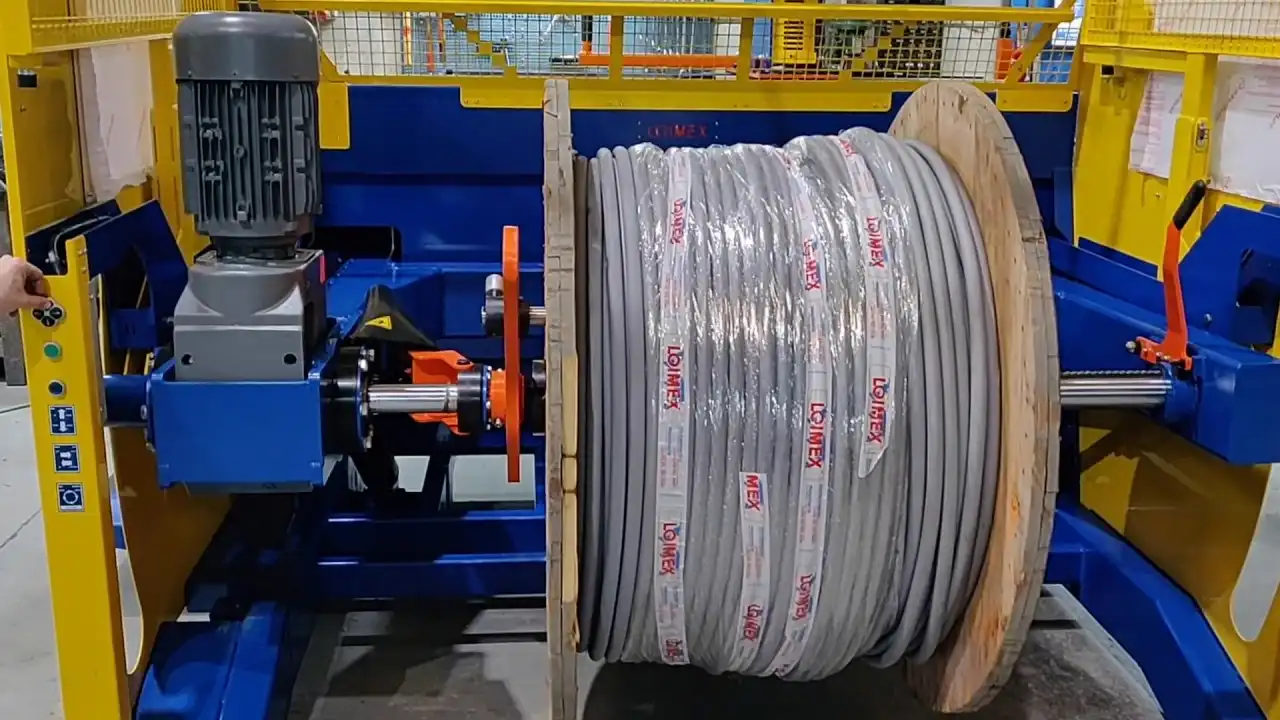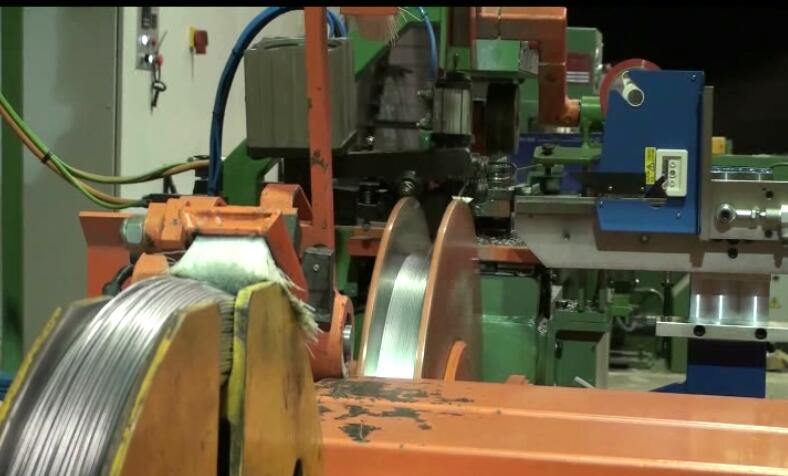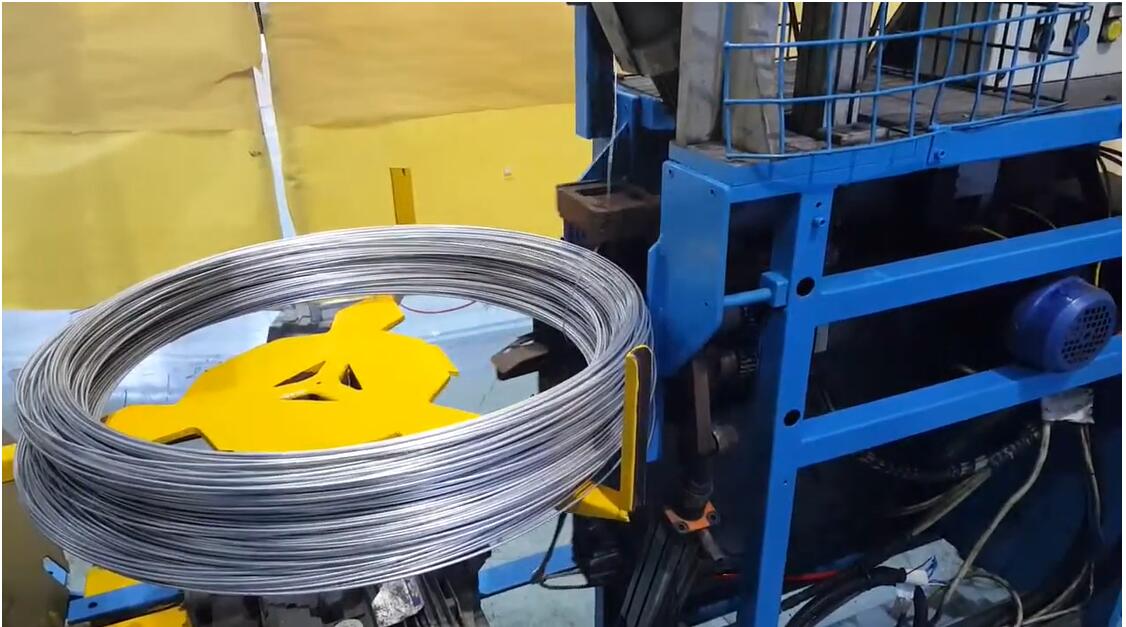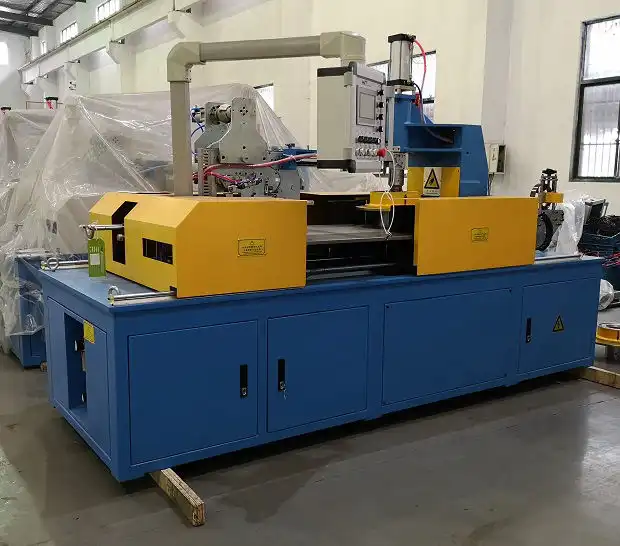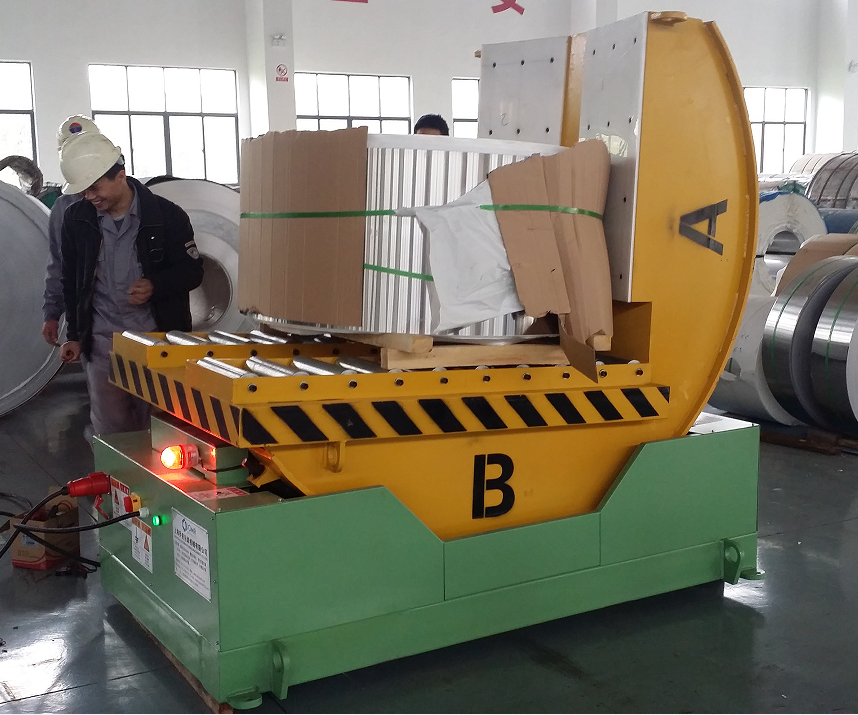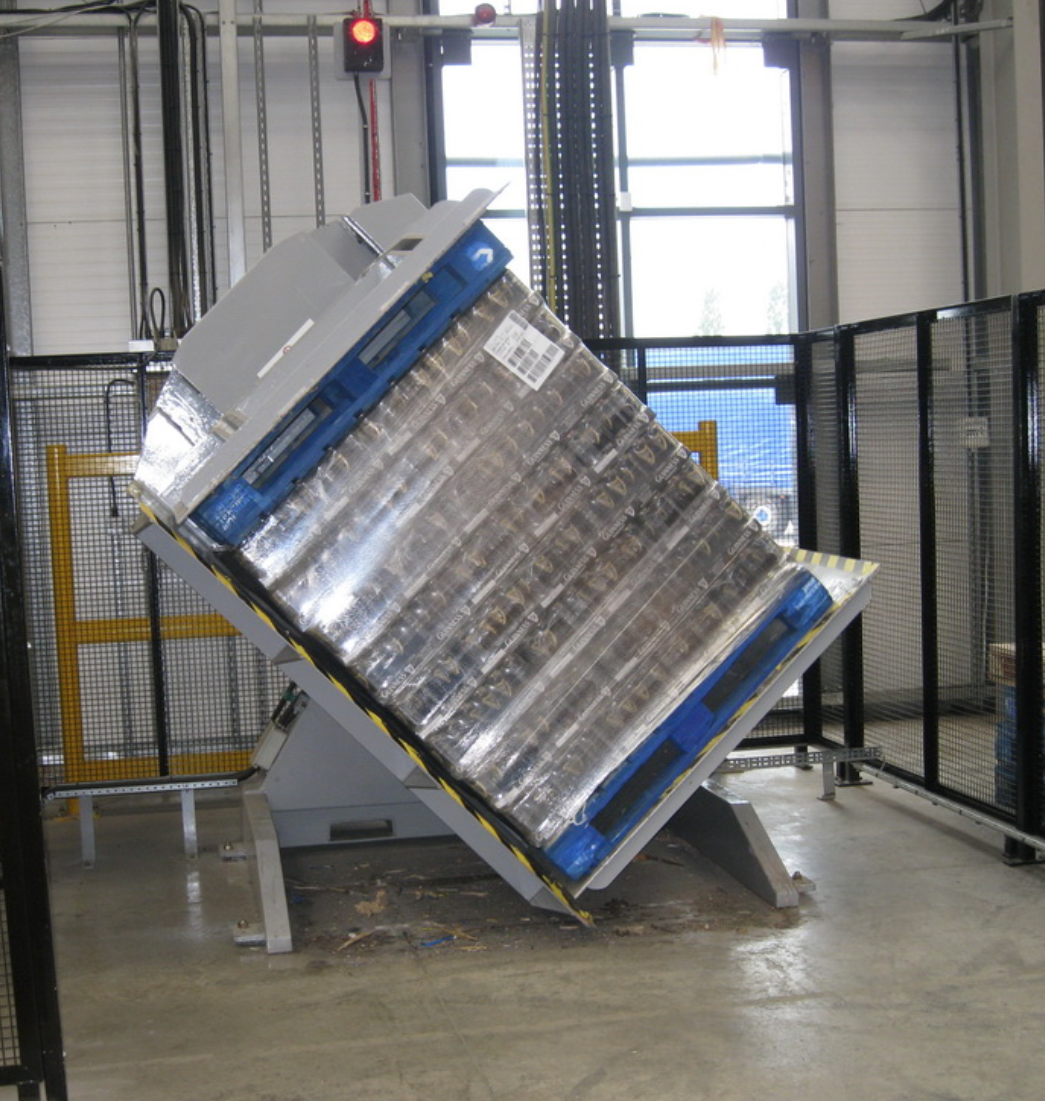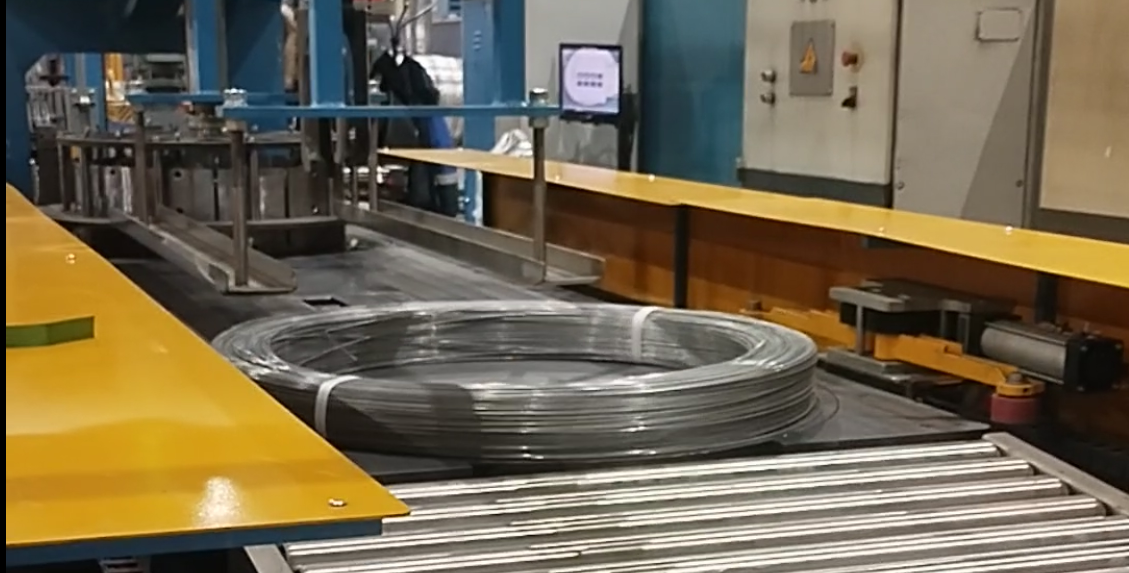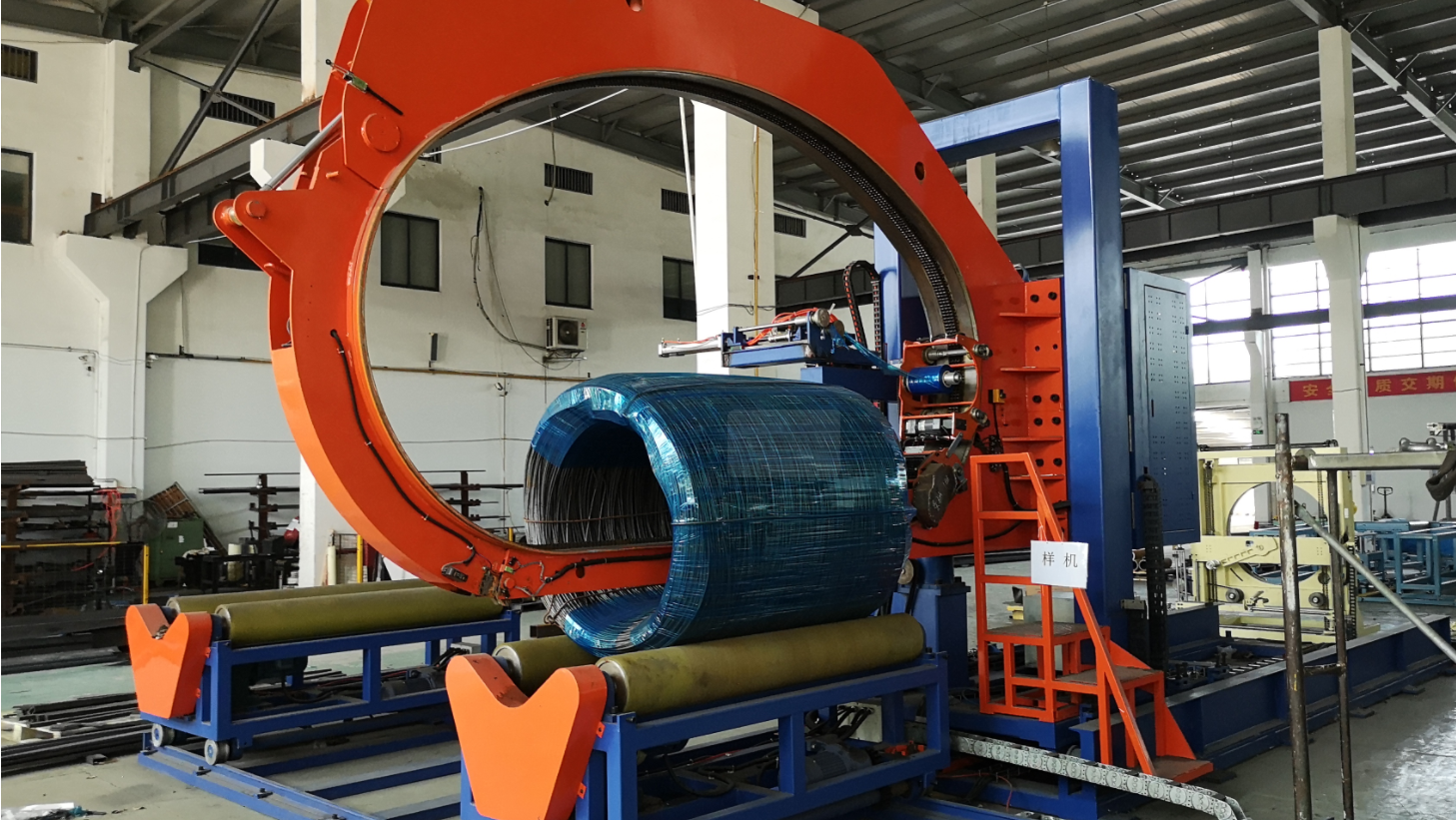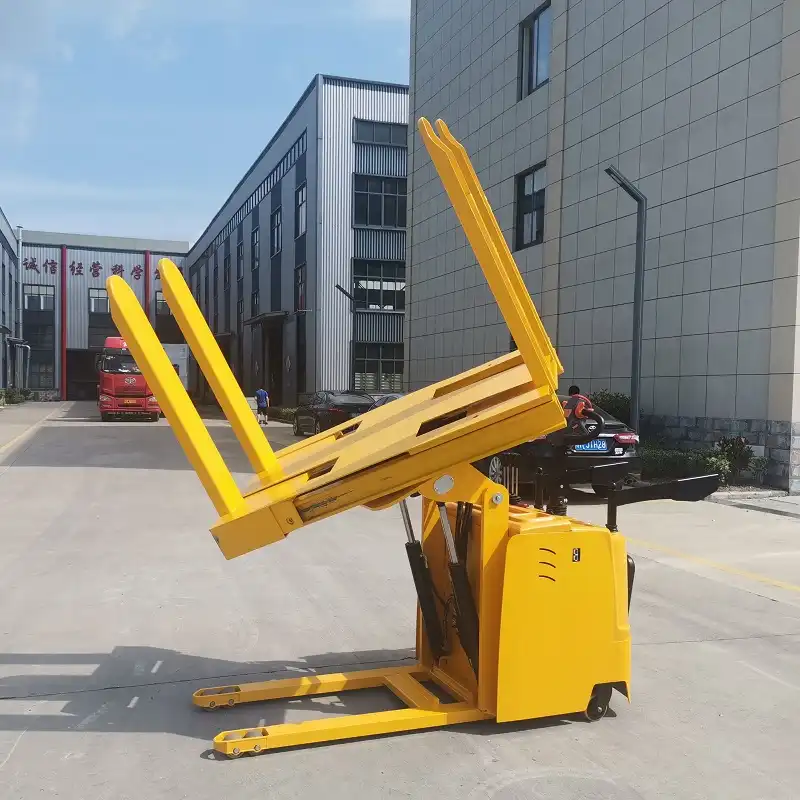How to Adjust Tension Settings for Steel Coil Packing Line Bundling Straps?
Are you struggling to keep your steel coils securely bundled on your packing line? Loose straps can lead to product damage and unsafe handling, while over-tightening can crush your coils. Finding the sweet spot for tension is crucial for efficient and damage-free steel coil packing.
Adjusting tension settings for steel coil packing line bundling straps involves a systematic approach: First, understand your coil specifications (weight, dimensions). Then, consult your strapping tool and strap manufacturer’s guidelines for recommended tension ranges. Begin with a lower tension setting, gradually increasing it while monitoring strap indentation and coil stability. Use a tension meter for precise adjustments and consistent results across all bundles. Fine-tuning these settings ensures optimal load security without causing coil damage, leading to safer and more efficient operations.
Achieving the perfect tension may seem like a balancing act, but with the right knowledge and techniques, you can master this critical aspect of steel coil packing. Let’s delve into the essential steps to ensure your steel coil packing line operates at peak performance.
Why Correct Tension Matters for Steel Coil Bundling Straps
Imagine your carefully stacked steel coils shifting during transit, straps loosening, and your product arriving damaged. The culprit? Incorrect bundling strap tension. Proper tension isn’t just about tightening straps; it’s about ensuring the integrity of your product and the safety of your operations.
Optimal tension in steel coil bundling straps is paramount for load stability and preventing damage. If tension is too low, coils can shift, leading to strap slippage and potential product damage. Conversely, excessive tension can indent or damage the coil edges and potentially break the strap. Finding the right balance ensures secure bundling, minimizes material waste, and guarantees safe handling and transportation of steel coils. This delicate equilibrium is key to efficient and cost-effective steel coil packing.
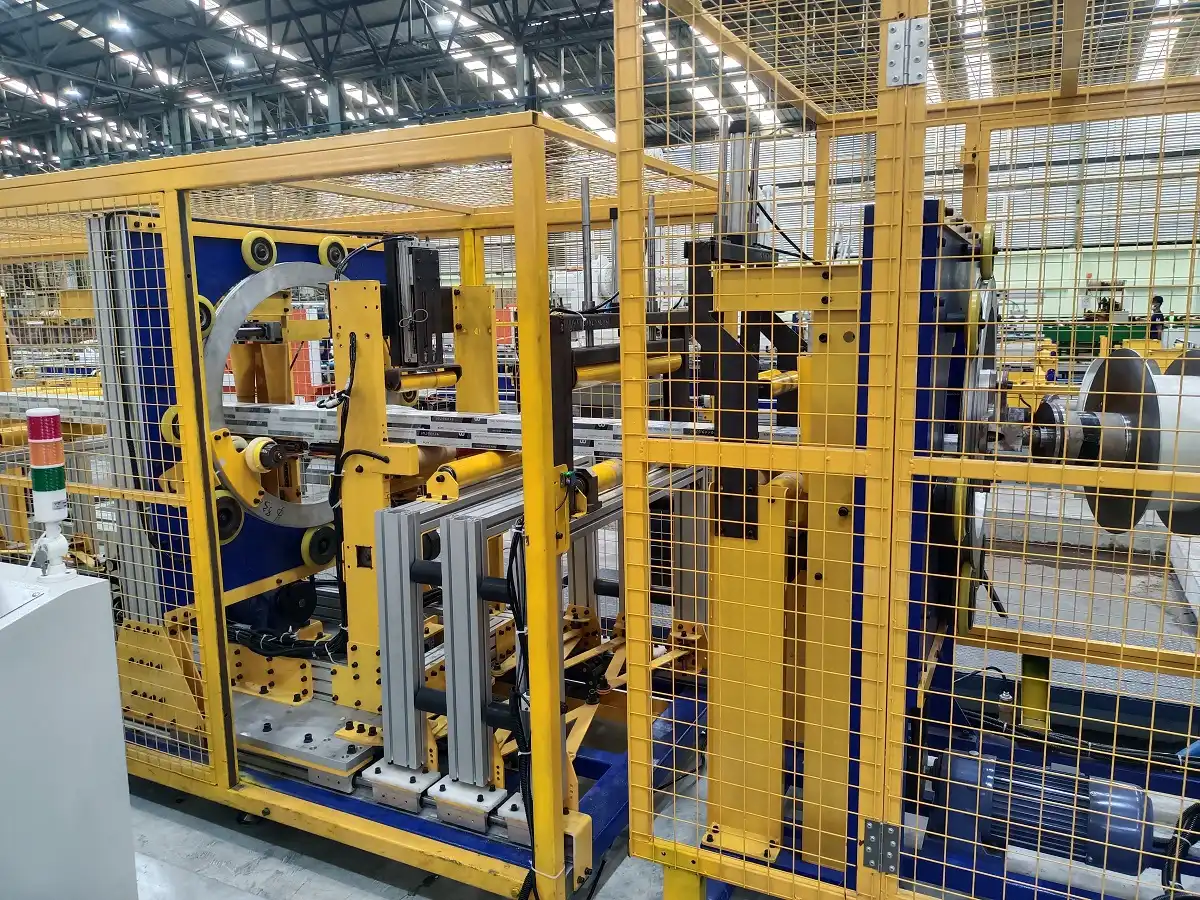
Diving Deeper: The Ripple Effect of Tension Mismanagement
Incorrect tension settings can trigger a cascade of problems extending beyond just damaged coils. Understanding these potential pitfalls is crucial for appreciating the importance of precise tension adjustment.
The Downward Spiral of Loose Tension
When bundling straps are too loose, the consequences can be multifaceted and detrimental to operational efficiency and product integrity.
| Problem | Description | Impact on Operations |
|---|---|---|
| Load Shifting | Coils within the bundle move independently. | Increased risk of accidents during handling, potential damage to equipment and personnel. |
| Strap Slippage | Straps lose grip and slide, especially during transit vibrations. | Bundle integrity compromised, product loss, potential delays in delivery. |
| Water Ingress | Gaps in bundling allow moisture to penetrate. | Rust and corrosion, decreasing the value and usability of steel coils. |
| Increased Rework | Unstable bundles require manual re-strapping and re-handling. | Higher labor costs, production bottlenecks, and delays in the packing process. |
The Perils of Over-Tensioning
Conversely, excessive tension presents its own set of challenges, often causing unseen damage that manifests later in the supply chain.
| Problem | Description | Impact on Product & Costs |
|---|---|---|
| Coil Indentation | Straps dig into coil edges, especially on softer steel grades. | Reduced coil quality, potential rejection by customers, diminished market value. |
| Edge Damage | Excessive pressure can deform or damage coil edges, rendering outer layers unusable. | Increased material waste, potential claims and disputes, higher production costs. |
| Strap Breakage | Overstressed straps can snap during tensioning or transit. | Safety hazards, production downtime, need for immediate line stoppage and repair. |
| Tool Wear & Tear | Over-tensioning strains strapping tools, shortening lifespan. | Increased maintenance costs, premature tool replacement, higher operational expenses. |
By recognizing these potential domino effects, operators can appreciate that precise tension control is not merely a step in the packing process, but a linchpin for overall operational success, product quality, and long-term cost savings.
Calculating Optimal Tension for Steel Coil Bundling Straps
Finding the "Goldilocks Zone" for tension – not too loose, not too tight, but just right – requires a bit of calculation and understanding of your specific coil and strapping parameters. Guesswork can lead to costly errors; a calculated approach ensures consistency and minimizes risk.
Calculating optimal tension for steel coil bundling straps involves considering key factors such as coil weight, dimensions, strap type, and tool specifications. Start by determining the total weight of the coil and the number of straps to be used. Consult strap manufacturer data for breaking strength and recommended working tension. Use a tension calculator or formula, often provided by strapping tool vendors, to estimate the ideal tension setting. Always test and fine-tune based on observed strap indentation and bundle stability.
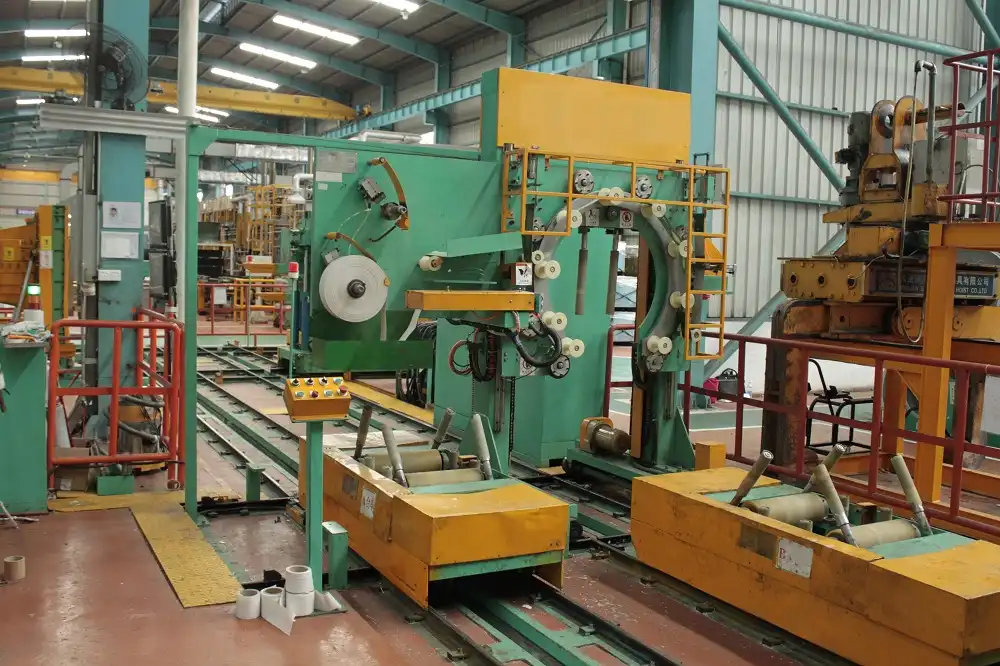
Formulating Your Tension Strategy: A Step-by-Step Guide
Moving beyond general guidelines, let’s break down the calculation process into actionable steps, providing a more concrete framework for determining optimal tension.
-
Coil Characteristics – The Foundation:
Begin by meticulously documenting the specifics of the steel coils you’re handling. This data is the bedrock of accurate tension calculation.
- Weight (W): The total mass of the coil in kilograms or pounds. This is the primary force the straps must counteract.
- Dimensions (D): Diameter and width of the coil. Larger coils inherently demand higher tension due to increased circumference and potential for shifting.
- Steel Grade (G): Softer grades are more susceptible to indentation and damage from over-tensioning, requiring a more delicate approach.
-
Strap Specifications – The Binding Agent:
Next, turn your attention to the bundling straps themselves. Not all straps are created equal; their material and dimensions dictate their strength and performance.
- Material (M): Steel, polyester, or polypropylene – each offers varying tensile strength and elongation properties. Steel straps generally offer the highest strength but less elongation.
- Width (Sw): Wider straps distribute tension more effectively, often allowing for slightly lower overall tension settings.
- Thickness (St): Thicker straps possess greater tensile strength and can withstand higher tension forces.
- Breaking Strength (BS): The maximum force a strap can endure before breaking. This crucial value is provided by the manufacturer and is essential for safety calculations.
-
Tool Parameters – The Application Mechanism:
The strapping tool is the interface between calculation and execution. Understanding its capabilities and settings is paramount.
- Tension Range (TR): The tool’s operational range, indicating the minimum and maximum tension it can apply.
- Tension Units: Ensure you are working with consistent units (e.g., Newtons, pounds-force) across calculations and tool settings.
- Adjustment Increments: The tool’s sensitivity – smaller increments allow for finer tension adjustments.
-
The Tension Formula – Putting It All Together:
While various formulas exist, a simplified approach to estimate the minimum required tension per strap (Tstrap) can be represented as:
T_strap ≈ (W g) / (N SF)
Where:
W= Coil Weight (kg)g= Acceleration due to gravity (9.81 m/s²)N= Number of StrapsSF= Safety Factor (typically 2-3, accounting for dynamic forces during handling and transit)
Important Note: This formula yields a minimum estimate. Always consult strap and tool manufacturer guidelines for recommended working tension ranges, which are often expressed as a percentage of the breaking strength (e.g., 50-70% of BS).
-
Iterative Refinement – The Art of Fine-Tuning:
Calculation is just the starting point. Real-world conditions necessitate a process of iterative refinement:
- Start Low: Begin with a tension setting at the lower end of the calculated or recommended range.
- Observe Indentation: After applying straps, carefully inspect for excessive indentation on coil edges. Minimal indentation is acceptable; deep marks indicate over-tensioning.
- Assess Bundle Stability: Manually try to shift the bundled coils. There should be minimal movement within the bundle.
- Incremental Adjustments: Gradually increase tension in small increments, repeating steps 5b and 5c until optimal balance is achieved.
- Tension Meter Verification: Employ a calibrated tension meter to precisely measure applied tension, ensuring consistency across bundles and validating tool settings.
By systematically following these steps, you transition from guesswork to a data-driven approach, maximizing bundling security while safeguarding coil quality and minimizing operational risks. Remember, manufacturer guidelines and practical observation are indispensable complements to any formulaic calculation.
Best Practices for Fine-Tuning Steel Coil Bundling Strap Tension
Calculations provide a starting point, but the real art of tension adjustment lies in the practical application and fine-tuning on the packing line. Adhering to best practices ensures consistency, safety, and optimal bundling performance.
To achieve ideal steel coil bundling strap tension, prioritize consistent tension application using calibrated tools. Begin with manufacturer-recommended settings, then incrementally adjust based on load type and visual inspection. Always use a tension meter to verify and maintain consistent tension across all straps. Regularly train operators on proper techniques and emphasize the importance of even tension distribution. Finally, implement a routine check and re-tensioning protocol before shipment to account for any settling or loosening.

Mastering Tension Application: A Practical Guide
Moving from theoretical calculations to hands-on adjustments requires a focus on technique, tools, and continuous monitoring. Let’s explore the best practices that separate effective tensioning from guesswork.
-
The Right Tools for the Job: Tensioner Selection:
The tensioner is your primary instrument for controlling strap tension. Selecting the appropriate type is crucial for achieving consistent and accurate results.
- Manual Tensioners: Suitable for lower volume operations or lighter gauge straps. Offer simplicity but rely heavily on operator skill for consistency.
- Pneumatic Tensioners: Air-powered, providing greater power and consistency than manual tools, ideal for medium to high-volume lines. Offer adjustable tension settings.
- Electric Tensioners: Offer the highest level of precision and automation. Often feature digital tension readouts and programmable settings, crucial for high-throughput and demanding applications.
Feature Manual Tensioner Pneumatic Tensioner Electric Tensioner Tension Control Operator Dependent Adjustable, More Consistent Highly Precise, Programmable Speed Slower Medium Fast Ergonomics Can be physically demanding Ergonomic Design Available Ergonomic, Reduced Operator Fatigue Cost Lowest Initial Cost Medium Initial Cost Highest Initial Cost Best For Low Volume, Light Gauge Strapping Medium to High Volume, Various Strap Gauges High Volume, Heavy Duty, Precision Required -
Step-by-Step Tensioning Procedure: Achieving Uniformity:
Consistency is paramount for bundle integrity. A standardized tensioning procedure minimizes variability and ensures each strap contributes equally to bundle security.
- Strap Placement: Position straps evenly around the coil circumference, considering load distribution and support points.
- Initial Tensioning: Apply initial tension to all straps in sequence, just enough to snug them against the coil.
- Incremental Tensioning: Increase tension on each strap in small, measured increments, moving sequentially around the coil. Avoid fully tensioning one strap before moving to the next – this can lead to uneven pressure.
- Tension Meter Verification: After each tensioning cycle, use a calibrated tension meter to measure the tension in each strap. Aim for tension values within the pre-calculated optimal range and with minimal variation between straps.
- Final Check: Once target tension is reached on all straps, visually re-inspect for strap indentation, bundle stability, and overall security.
-
Operator Training: The Human Element of Precision:
Even with advanced tools, operator skill remains a critical factor. Comprehensive and ongoing training is essential for maintaining tensioning accuracy and consistency.
- Tool Operation: Thorough training on the correct and safe operation of chosen tensioning tools, including adjustment procedures, maintenance, and troubleshooting.
- Tension Theory: Educate operators on the principles of tension, its impact on load stability and coil integrity, and the consequences of incorrect settings.
- Visual Inspection: Train operators to recognize visual cues of correct and incorrect tension – acceptable indentation vs. over-tensioning, strap slippage vs. secure grip.
- Tension Meter Usage: Hands-on training on the proper use of tension meters, including calibration checks, measurement techniques, and interpretation of readings.
- Regular Refreshers: Implement periodic refresher training to reinforce best practices, introduce new techniques or equipment, and address any emerging issues or inconsistencies.
By combining the right tools, standardized procedures, and well-trained operators, you create a robust tensioning process that minimizes variability, maximizes bundle security, and safeguards your steel coils throughout the packing and transportation cycle. Consistent tensioning is not just about tightening straps; it’s about building a reliable and efficient packing operation.
Automated Tension Control in Steel Coil Packing Lines
Manual tension adjustment, while effective with skilled operators, can introduce variability and is less efficient for high-volume packing lines. Automated systems offer precision and consistency, streamlining the process and reducing reliance on manual intervention.
Automated tension control in steel coil packing lines utilizes sensors and programmable logic controllers (PLCs) to maintain consistent strap tension. Sensors monitor strap tension in real-time, feeding data back to the PLC, which automatically adjusts the tensioning mechanism. This closed-loop system ensures uniform tension across all bundles, increases packing speed, reduces material waste, and minimizes the risk of human error. Automated tension control is essential for high-throughput, precision-driven steel coil packing operations.
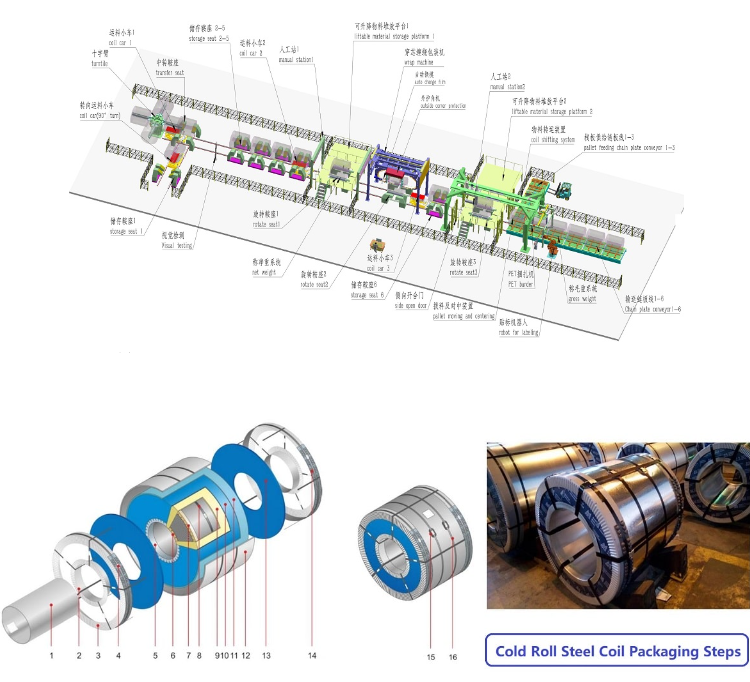
Automated tension control systems represent a significant leap forward in optimizing steel coil packing lines. They address the limitations of manual adjustments, offering enhanced precision, speed, and reliability. Here’s a closer look at the key components and benefits:
Core Components of Automated Tension Control Systems
-
Tension Sensors: These are the eyes of the system, providing real-time feedback on strap tension. Various types are used:
- Load Cells: Highly accurate, measure force directly applied to the strap.
- Strain Gauges: Detect strap elongation, indirectly indicating tension.
- Optical Sensors: Non-contact, measure strap deflection or vibration frequency to infer tension.
-
Programmable Logic Controllers (PLCs): The brains of the system, PLCs process sensor data and control the tensioning mechanism.
- Closed-Loop Control: PLCs implement sophisticated algorithms to maintain target tension by continuously adjusting the tensioner based on sensor feedback.
- Programmable Settings: Operators can input coil specifications, strap type, and desired tension parameters via a user-friendly interface.
- Data Logging & Monitoring: Advanced PLCs record tension data for quality control, process optimization, and predictive maintenance.
-
Automated Tensioning Mechanisms: These actuators respond to PLC commands to adjust strap tension.
- Servo-Controlled Tensioners: Electric servo motors provide precise and rapid tension adjustments.
- Pneumatic Actuators: Air-powered cylinders offer robust and reliable tensioning force.
- Magnetic Brakes: Employ magnetic force to control strap feed and tension, offering smooth and consistent application.
Benefits of Automation: Beyond Consistency
The advantages of automated tension control extend beyond simply maintaining uniform strap tension. They contribute to a more efficient, safer, and cost-effective packing operation.
- Enhanced Consistency & Quality: Eliminates operator variability, ensuring every bundle is strapped to the same precise tension, minimizing damage and rework.
- Increased Throughput: Automated systems tension and seal straps faster than manual methods, boosting packing line speed and overall productivity.
- Reduced Material Waste: Precise tension control minimizes strap over-tensioning, reducing strap breakage and material consumption.
- Improved Safety: Automation reduces manual handling of heavy tools and straps, minimizing operator fatigue and risk of injury.
- Data-Driven Optimization: Logged tension data enables process analysis, identification of trends, and continuous improvement of packing parameters.
- Reduced Labor Costs: Automation reduces the need for manual operators dedicated solely to tensioning, freeing up personnel for other tasks.
By integrating automated tension control, steel coil packing lines move towards a future of greater efficiency, precision, and data-driven optimization, ensuring consistent quality and minimizing operational costs in the long run.
Streamlining Tension Adjustment in Your Packing Line: A Practical Approach
Implementing effective tension adjustment doesn’t require a complete overhaul of your packing line. Often, incremental improvements and a focus on operator training can yield significant results.
To streamline tension adjustment in your steel coil packing line, start with operator training on best practices and tool usage. Implement a standardized tensioning procedure and incorporate tension meters for regular verification. Gradually upgrade to automated tensioning tools or systems for improved consistency and efficiency in high-volume settings. Regularly review and adjust tension parameters based on coil types and feedback from quality control. Focus on incremental improvements and data-driven adjustments for optimal and sustainable results.

Transitioning to optimized tension adjustment is a journey of continuous improvement. Here’s a phased approach to guide your efforts:
-
Phase 1: Foundational Training and Standardization (Short-Term Wins):
- Comprehensive Operator Training: Invest in thorough training programs focusing on correct tensioning techniques, tool operation, safety protocols, and visual inspection for tension issues.
- Standardized Procedure Development: Create a written, step-by-step procedure for tensioning straps, outlining coil types, strap specifications, target tension ranges, and tool settings.
- Tension Meter Integration: Introduce calibrated tension meters and train operators on their proper use for verifying and documenting tension levels.
- Regular Audits and Feedback: Implement periodic audits of tensioning practices and provide operators with constructive feedback to reinforce best practices.
-
Phase 2: Tool Upgrades and Data Collection (Mid-Term Enhancement):
- Ergonomic Tool Implementation: Upgrade to pneumatic or electric tensioning tools to reduce operator fatigue and improve consistency.
- Digital Tension Readouts: Utilize tools with digital displays for precise tension settings and eliminate guesswork.
- Data Logging Introduction: Explore tensioning tools or systems that can log tension data for each bundle, enabling basic quality control tracking.
- Material and Parameter Review: Regularly review strap specifications, coil types, and tension parameters. Adjust procedures as needed based on performance data and changing product mixes.
-
Phase 3: Automation and System Integration (Long-Term Optimization):
- Automated Tension Control System Implementation: Integrate automated tension control systems with sensors, PLCs, and servo-controlled tensioners for high-precision and high-throughput operations.
- Real-Time Monitoring and Adjustment: Leverage automated systems for real-time tension monitoring, automatic adjustments, and alerts for deviations.
- Data Analytics and Predictive Maintenance: Utilize logged tension data for in-depth process analysis, predictive maintenance scheduling, and continuous system optimization.
- System Integration: Integrate tension control data with overall packing line management systems for comprehensive operational visibility and control.
By adopting this phased approach, you can systematically enhance your tension adjustment process, moving from basic improvements to advanced automation, ensuring optimal steel coil bundling for years to come. Remember, consistent, incremental progress combined with data-driven decisions is the key to achieving sustainable and impactful results.
Conclusion
Mastering tension adjustment for steel coil packing line bundling straps is a critical component of efficient and safe material handling. By understanding the principles of tension, implementing best practices, and leveraging both manual techniques and automated systems, manufacturers can significantly improve their packing operations. Focusing on precise tension adjustment is not just about securing coils; it’s about optimizing your entire steel coil packing line for enhanced productivity, reduced costs, and superior product protection. Explore coil packing line solutions to further streamline your operations.


